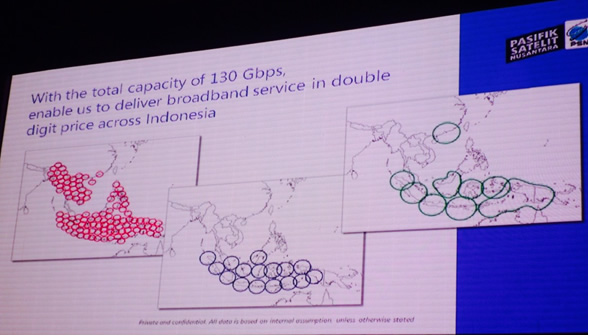| Is China rolling up Asian HTS demand? | The current page: Home -> Great Wall in Media |
by Peter B. de Selding | May 18, 2017

Indonesia's PT PSN on May 17 said three planned satellites — Palapa 6, to launch this year; Palapa-N1, to launch in 2019 and a Palapa-7, still to be placed under firm contract with China — will deliver a combined 130 Gbps to Indonesian territory.
Credit: PSN
PARIS — China's latest manufacturing wins in Indonesia for high-throughput satellites (HTS), coupled with earlier contracts in Thailand and Hong Kong, indicate the challenge facing U.S.- and European-based Internet-delivery constellations planning global coverage.
The news does not get better outside China's expanding reach. India too, which like China has set a high priority on building its own communications satellites — to the point of riding roughshod over international open-access trade regulations — has three HTS satellites on the way.
None of these systems has the throughput of a ViaSat Inc. terabit-per-second ViaSat-3 satellite, whose Asia-Pacific model is still not on order but could be ready as early as 2020 or 2021.
Nor do they include the everywhere/always coverage of low-orbiting constellations being planned by OneWeb, SpaceX, Telesat and others.
But they have an apparently indispensable home-made or regionally made label.
Here's how the chief executive of one company working on a global broadband-delivery constellation assessed the situation:
"Look, nations like China and India have long proved that they are willing to sacrifice a little time, to be behind Western technology, on behalf of providing their own systems in their territories," said this official, whose company has had mixed results in China and India. "As things stand now, securing landing rights into these nations will be difficult."
Flanked by the Indonesian Minister of Communications and Telematics, Rudiantara, Indonesia's PT Indosat Ooredoo and PT PSN on May 17 announced a joint venture that would purchase an HTS satellite from China Great Wall Industry Corp. (CGWIC), for about $220 million including the satellite's construction, launch, a partial ground segment and financing charges.
The satellite, Palapa-N1, will have an estimated throughput of 12 Gbps. The Indonesia group also signed a memorandum of understanding for a Palapa-7 satellite, also to be provided by CGWIC, which will have 100 Gbps of throughput.
The announcement, at the APSAT 2017 conference in Jakarta, Indonesia, followed the October 2016 contract between CGWIC and Thaicom of Thailand for a Thaicom 9 spacecraft — the name may change — that will launch in 2019 and carry 53 Gbps of throughput. The contract was valued at $208 million.
Also in 2016, APT Satellite Holdings of Hong Kong, which is majority-owned by China Aerospace Science and Technology Corp. (CASC), announced it would take a 30% stake in an Apstar-6D satellite, to be supplied by CGWIC. APT's initial 30% share of the investment is valued at about $86 million.
APT had been designated as the focal point for a global HTS broadband system built in China, but the timing of that network remains unclear.
In India, 4 Gbps to 14 Gbps to 70 Gbps in two years
The Indian satellite program, unlike the country's PSLV rocket, has not been present internationally yet. But domestically, the Indian Space Research Organization (ISRO), keeps tight control over India's domestic satellite communications market. ISRO allows non-Indian satellite fleet operators to access India's market only under volume and pricing conditions approved by ISRO.
That may be the same policy in broadband, despite a years-long effort by EchoStar Corp.'sHughes Network Systems to extend its consumer satellite broadband business, a success in the United States and now starting in Brazil and Colombia, to India.
ISRO plans to launch three HTS satellites in the coming two years. The GSAT-9, to be launched in June by India's newly upgraded GSLV-Mark 3 rocket, has 4 Gbps of capacity.
The GSAT-11, to launch late this year aboard an Arianespace Ariane 5 vehicle, has 14 Gbps of throughput. GSAT-20, to launch in 2018 on the GSLV, has 70 Gbps of throughput.
Imagining a global constellation without China and China
China and India alone account for more than one-third of the global population and a much larger share of the unserved/underserved broadband market that new global broadband satellite systems view as their core market.
If both nations are going to be closed for business to companies seeking millions of Indian and Chinese subscribers, the business model of more than one prospective satellite broadband player will need to be revised.
LEO constellations have already been criticized for spending too much time over the poles and oceans. If they're flying, largely unused, over much of Asia as well, closing the multibillion-dollar business case will be that much more difficult.
In a statement following the Indosat/PSN contract, Indonesia's Communications Ministry said the deal indicates that the government's broadband-access policy is being adopted by Indonesia's telecom industry.
"Broadband access is the key to getting more information and benefits from the digital world.This new satellite will help accelerate broadband penetration and realize what the government seeks to become the largest digital country in Southeast Asia," said Alexander Rusli, chief executive of Indosat Ooredoo, in a statement.
Minister Rudiantara added: "We need satellites and we need broadband and we must also ensure enough bandwidth. We are witnessing a joint venture between Indosat, PSN and CGWIC. "
Date:2017-05-18

